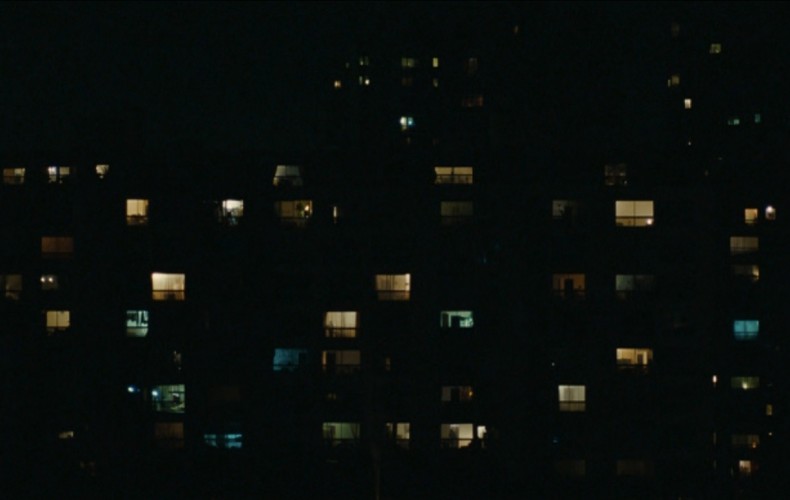I’ve been wanting to write about Claire Denis’ film for a long time now; wanting to write about this subtle evocation of a particular Paris, and of particular Parisian lives.
The film gives us another Paris, free from the architectural jewellery of Woody Allen’s touristic Midnight in Paris; free also from the violent outsiderness of the banlieues in La Haine. This is inner Paris, but a view of the city completely free of its iconography. The film’s cast are largely French-Caribbean, and there is a sense of their rootedness and stability within the city, which is partly conjured by Denis’ laconic cinematography and partly through the observation of daily rituals in which the film is so absorbed.
The film establishes its mise-en-scene through a long wordless sequence of trains moving in out of tunnels, gliding through the northern suburbs and then edging back into the Gare de Nord, all the time watched over by the faceless apartment blocks overlooking the tracks.
The four central characters in the film, Lionel a train driver, his student daughter Josephine, their neighbour Gabrielle, a cab driver, and Noe, a young man with his eye on Josephine, all live in the same apartment block, and their lives interconnect in complex ways. Most of the film’s reviewers have focused on the characters’ relationships; the hidden histories and desires which link them together, and the way the characters feelings are expressed through body language, gesture and physical touch. Adrian Martin’s neat summation of Denis’ films as ‘a cryptic diagram of bodies and desires, environments and landscapes, confrontations and evasions, things said and unsaid’ is nowhere more fully expressed than in this film (Adrian Martin, Sight and Sound, July 2010)
Absorbing though these relationships are, it was towards the film’s sense of place that my interest lies. The film seems to take place entirely at dawn or at dusk, bookending the working day. Lionel’s work as a train driver on the RER suburban routes, and Gabrielle’s work as a minicab driver, in and around the city, gently insinuate them (and us as viewers) into its daily rhythms. Colleagues meet and drink in neighbourhood bars, to celebrate retirements, or just to put the world to rights. The longuers of the minicab driver’s life allow time to pause and reflect at the café counter.
This is a film of anonymous cityscapes and quiet domestic interiors. Characters watch doorways, hang out on stairwells, call to each other across courtyards. Josephine cooks for Lionel when he returns home; intimacies are shared (and avoided) over coffee. Precise locations in the film are hinted at but rarely given away; the action is centred on or near the Rue De Gaudoloupe, one of the few references Denis allows us.
The story pivots around the four friends’ trip to a concert, when at last the ritualized cycle of work and college is interrupted. Where the concert takes place is never explained, but the need to drive there suggests the outskirts of Paris, beyond the peripherique.
When Gabrielle’s taxi breaks down en route to the gig, the characters seek shelter in an African café, during a heavy rainstorm. The scene in the cafe where the characters swap partners as they dance to ‘Night Shift’, by the Commodores, becomes the centrepiece of the film, establishing true affections between the characters, allowing particular relationships to blossom, while ruling out others.
Bu bonus, üyelere para yatırdıkları her seferinde para yatırma miktarının belli bir oranı kadar bonus veren siteler tarafından ücretsiz kredi deposu olarak verilir.
With the air cleared, the terrain of the film can finally open out, and Lionel and Josephine decide to visit her aunt in Lubeck, Germany. Where Paris was defined by utilitarian blocks, and stark modern interiors, Lubeck is a museum piece, gothic on the outside, and chintzy on the inside. The visit to Lubeck is fleeting, and includes a night in Lionel’s campervan by the Baltic sea, before the return to Paris and the familiarity of neighbourhood.
As Joseph Rykwert observes in The Seduction of Place, the city has two principal functions, dwelling and movement, and these impulses underpin the film. Denis’ main characters all inhabit the same building, but this never feels like an awkward plot device, and the film’s sensitivity makes intimate communication between neighbours feel natural and authentic. Over the course of the day, each character follows their circumscribed journeys – on foot to college; driving cabs around the inner city; driving the RER train out through the banlieues. Only Noe has the desire and the potential to move further away. He talks of travel to Africa, and his restlessness is a key counterpoint to the rootedness of the other characters.
Capturing the lived, felt, genuinely authentic presence of a city is a difficult task, either in writing or film. Denis’ portrait of a particular Parisian milieu seems exemplary in this respect. It doesn’t attempt to capture the vibrancy of ‘street life’ in the local sense, or celebrate the thrusting globalization of the mega-city. It inhabits, graciously, another place.


Leave a Reply